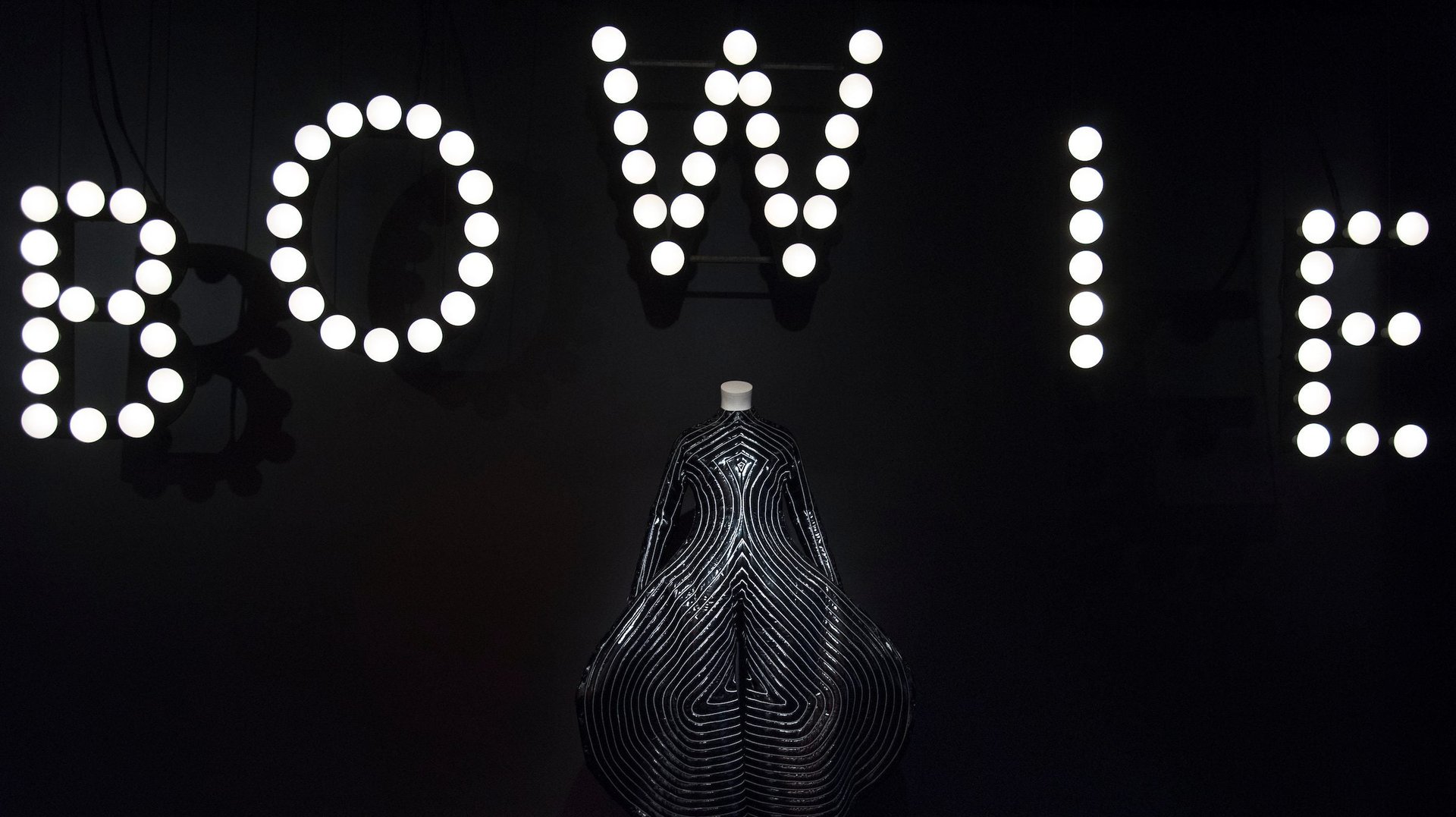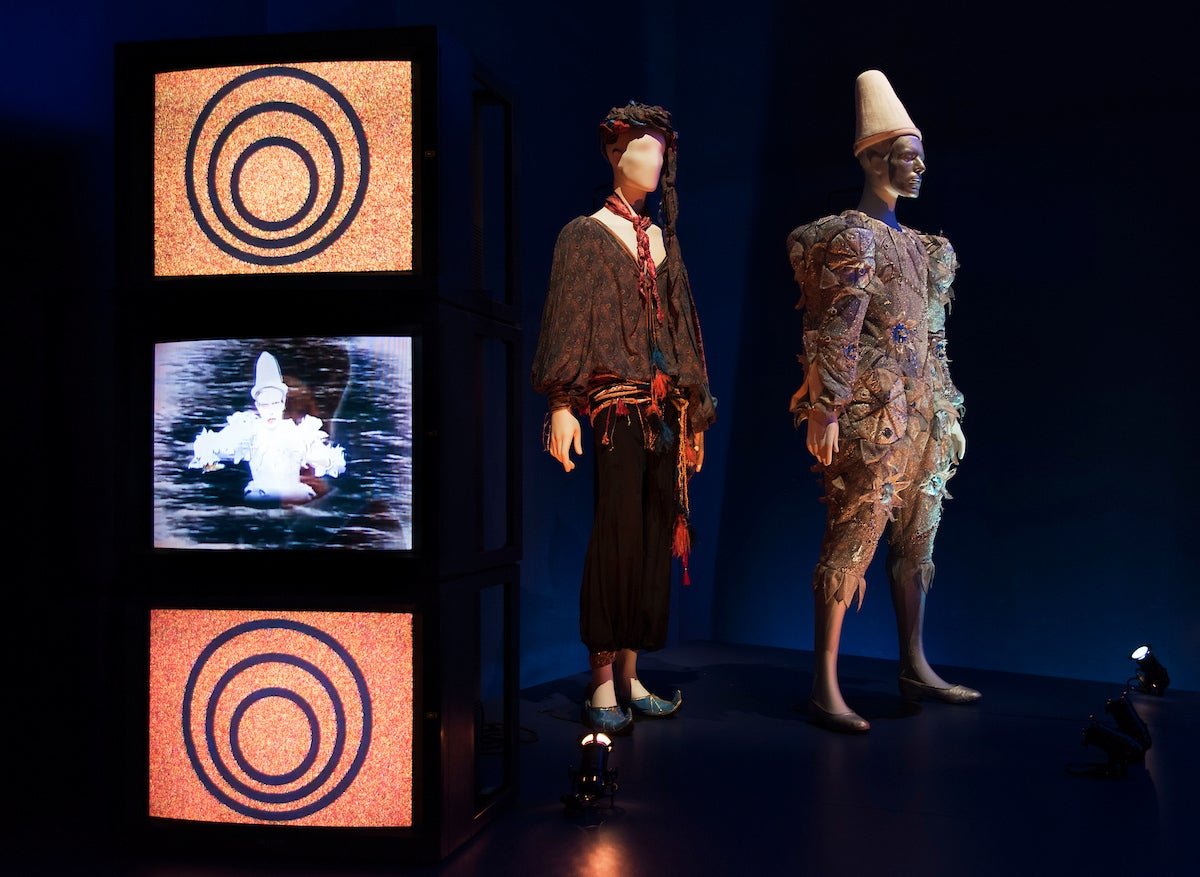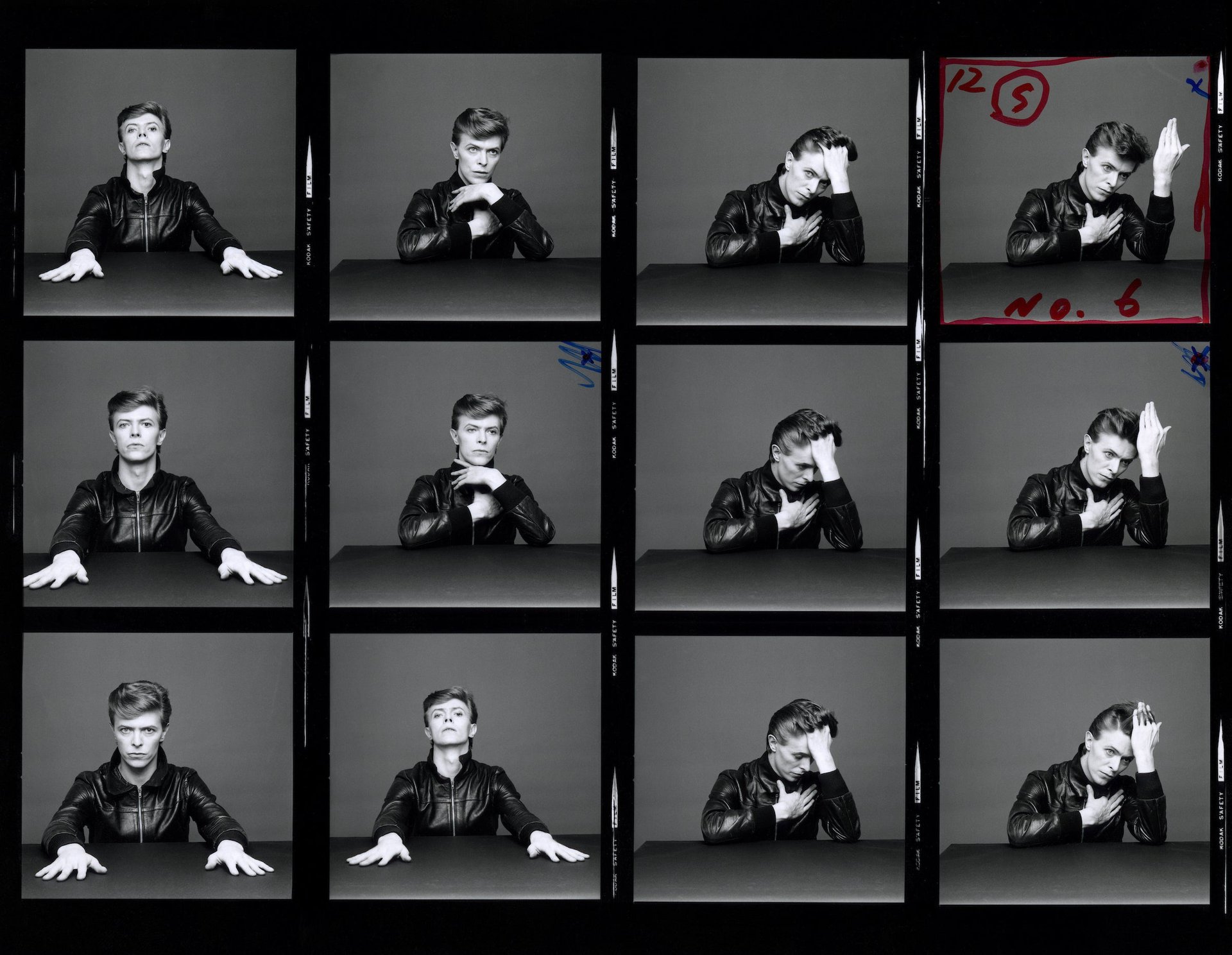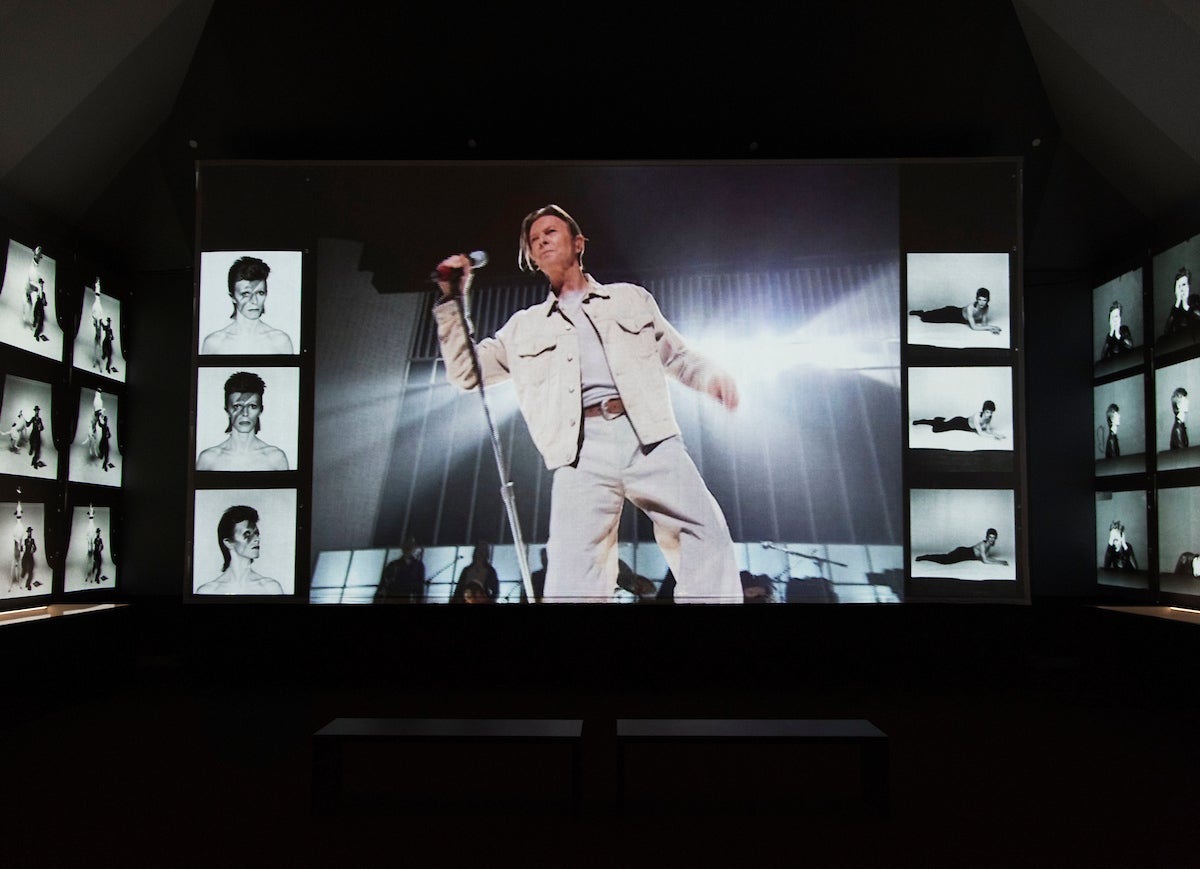Rock’s biggest stars are sending their memorabilia out on world tours
David Bowie died in 2016, but he is still on tour, selling out shows around the world.


David Bowie died in 2016, but he is still on tour, selling out shows around the world.
An exhibition of audio, video, costumes, and a remarkable trove of personal mementos from the archives of the late-musician’s career, assembled under the title David Bowie Is landed in the late-musicians’ adopted hometown of New York this past weekend, at the Brooklyn Museum. Running through July 15, the exhibition is the last stop on a five year world tour that began at the Victoria & Albert Museum in London in 2012, and has included stops in ten cities across five continents.
While the list of countries visited is remarkable enough, what’s truly staggering is the fact that nearly two million people have attended the exhibition; further proof not only of Bowie’s enduring appeal, but of the increasingly creative ways musicians are reaching their fans beyond just their music.
“It really has exceeded all of our expectations,” says Geoffrey Marsh, one of the curators of the original V&A exhibition. “It’s an amazing and exciting way for David Bowie’s fans—and even people just discovering him—to connect with him in a unique and extraordinary and completely immersive way.”

In 1969, when The Beatles were in the midst of splitting, John Lennon had grand plans for his new venture with his wife Yoko Ono, which the couple dubbed Plastic Ono Band. A homebody by nature, rather than “joining the traveling flea circus,” as he once called the life of a performing rock-and-roller, Lennon envisioned sending his latest record, along with wax figures, cardboard cutouts, or even a diorama of a band, on tour instead.
With stadium rock concerts in their infancy, but gaining steam as a way for musicians to generate tremendous income, Lennon’s idea that anything less than a personal appearance would draw a crowd seemed a fanciful scheme. Not surprisingly, it took more than forty years and someone with the audacity and vision like Lennon’s close friend Bowie to actually pull off the idea.
The idea for David Bowie Is was hatched by the V&A more than four years before the artist’s death. But true to form, it’s an ahead-of-the-curve demonstration of the way rock stars—dead or alive—can keep the public interested (and the dollars rolling in) beyond the typical album-concert tour-album cycle. A far cry from the few guitars from disparate artists on the wall of your local Hard Rock Cafe, or even the photo exhibits from rock’s heyday that have become the rage, rock and roll’s elite are doing what Lennon envisioned more than forty years ago: They’re sending memorabilia on the road.
The Rolling Stones’ Exhibitionism drew substantial crowds to a New York show last year featuring not much more than stage clothes and guitars, while former Oasis kingpin Noel Gallagher has a small but fantastic pre-concert exhibit of his handwritten lyrics, awards, and memorabilia for fans willing to pay a small charge above the standard ticket price on his current tour. But it’s taken Bowie, and fellow UK rock pioneers Pink Floyd, with their recent sold-out V&A show Their Mortal Remains, now in Rome, to really make the idea work.
Both Bowie and Pink Floyd carved individual and unique paths in their creative journeys, blending audio, video and artistic elements. Fittingly, the respective exhibits draw on the rich—although vastly different—visual elements the artists used throughout their careers.
Much like Bowie, “Pink Floyd evolved into something that was more than just their music,” says Ray Winkler, the CEO and Design Director of Stufish, a UK design firm, and also the exhibition architect of the Pink Floyd exhibit. Their music “was synonymous with a very strong visual language. That gave us so much to tap into.”
Winkler says this catalog of visuals was “independent of—and sort of ran in parallel with—the band’s musical career, and that helped us tell the story.”

Both shows are completely absorbing experiences. Mike Garson, Bowie’s pianist for much of his career, who is now on tour with Celebrating David Bowie, featuring a band of Bowie alums, advises taking at least two hours to see David Bowie Is.
“The immersive, audio-video nature of the exhibit—not just the costumes and memorabilia, which are stunning, too, of course—make it a really special experience,” says Garson, who will perform at a free concert at the David Bowie Is exhibition on April 7. “I saw one screen of us performing somewhere, with David singing and me on the keyboards, and I thought, ‘I’ve never seen that. Oh, my God.’ It made him come alive again.”
That’s exactly the feeling the Brooklyn Museum was hoping to accomplish with their version of David Bowie Is, says its director of exhibition design, Matthew Yokobosky, a lifelong Bowie fan. Yokobosky visited previous incarnations of the exhibition and says he has tried to give the Brooklyn edition a heightened chronological flow, with a more New York-centric flavor, as well as a greater focus on the artist’s time recording in Philadelphia in the mid-70s.
The exhibit features more than 100 never-before-seen items from Bowie’s archive, from the giant letters used on Bowie’s “five borough” tour of New York City after Sept. 11, which greet you upon entering the exhibit, to his pre-production notes—and even the black-starred, leather-bound book—from his final music video. “I grew up with David Bowie, so he’s very real to me, even though he’s gone. A lot of people coming to the show will not have that same connection,” Yokobosky says. “So it was important for us to put David Bowie in the here and now—in the present tense—and I think that’s what people will take away from the show.”
Yokobosky also says that, even as a diehard fan, he was surprised at how large Bowie’s influence looms.“David Bowie’s impact as an artist is enormous, and certainly much bigger than I realized before we started working on this show,” he says. “He is still everywhere.”
Visitors to David Bowie Is are enveloped in the late-artist’s world from the moment they enter the exhibition. Upon entering, they’re given a pair of headphones that, as they move around from station to station, offer narration from Bowie himself, as well as a soundtrack curated by Bowie’s longtime producer Tony Visconti.

Sennheiser designed the unique technology crucial to making David Bowie Is the emotional journey it is, which spokesman Robert Genereux describes as a more sophisticated and precise process than geolocation. “It detects where you are in the exhibit, and as you’re walking through it, the receiver says, ‘Okay, this person is in this zone, looking at a World War II ration book, so let’s play the file of David Bowie talking about his early life, and growing up in post-War Britain.”
The audio component is what really brings Bowie’s being and art to life, and it’s that sort of attention to detail, not to mention such Bowie-like use of state-of-the-art technology, that sets this exhibit apart from your typical museum-going experience.
“The breadth of David Bowie’s work and life—musician, painter, actor, writer, fashion and gay rights icon—was staggering to me when I first got involved with this project,” the V&As Victoria Broakes, who curated the original exhibition with Marsh, confesses. “We’re a museum of art, design and form, so the visual is incredibly important. I quickly came to realize that Bowie’s work was far more suited to this sort of exhibition, because he chose influences from such a wide range of artistic and cultural ideas. He was like a sort of walking encyclopedia; a conduit for his public to the ideas that inspired and moved him, whether those were German expressionism or Japanese kabuki, Stanley Kubrick or Fritz Lang. He was out experiencing those things, and then putting them into his work.”
When the exhibition opened in 2012, “it was an incredible moment,” Broakes says. “It became something picked up by live performers who suddenly thought, ‘Oh, that’s interesting. Here is a way to go on tour without leaving the country, in a way that gives a real sort of breadth and depth to the work that I do.’ But I don’t think it’s possible for just any performer, of course.”
Ray Winkler, who worked with Pink Floyd to create a similar, immersive experience, agrees that while exhibitions like Their Mortal Remains and David Bowie Is could be an easy way for aging artists to go on tour without actually hitting the road, and that art school-influenced bands like The Beatles and The Who might be ripe for similar shows, the medium is not right for every artist. Ultimately, he feels that it is artists like Pink Floyd and Bowie, who pushed the boundaries of pop and rock music in ways and mediums unimaginable to their peers, who make the best subjects for such projects.
“They were not just great artists, they were artists who really knew their craft, and so these exhibitions show how they beautifully wove together their incredible talent for music with an incredible talent to express that in some visual manner,” Winkler says. “Just having the time to reflect on some of these things, in a world where bands disappear like melting snow—it’s nice to see something that had real substance and survived beyond the lifespan of the artists themselves,” he adds. “That is what museums do best: They put these things into a time capsule that allows you to look at it at your own pace, in a world that is increasingly pressing the fast forward button, and to think about what amazing work these truly unique artists created.”